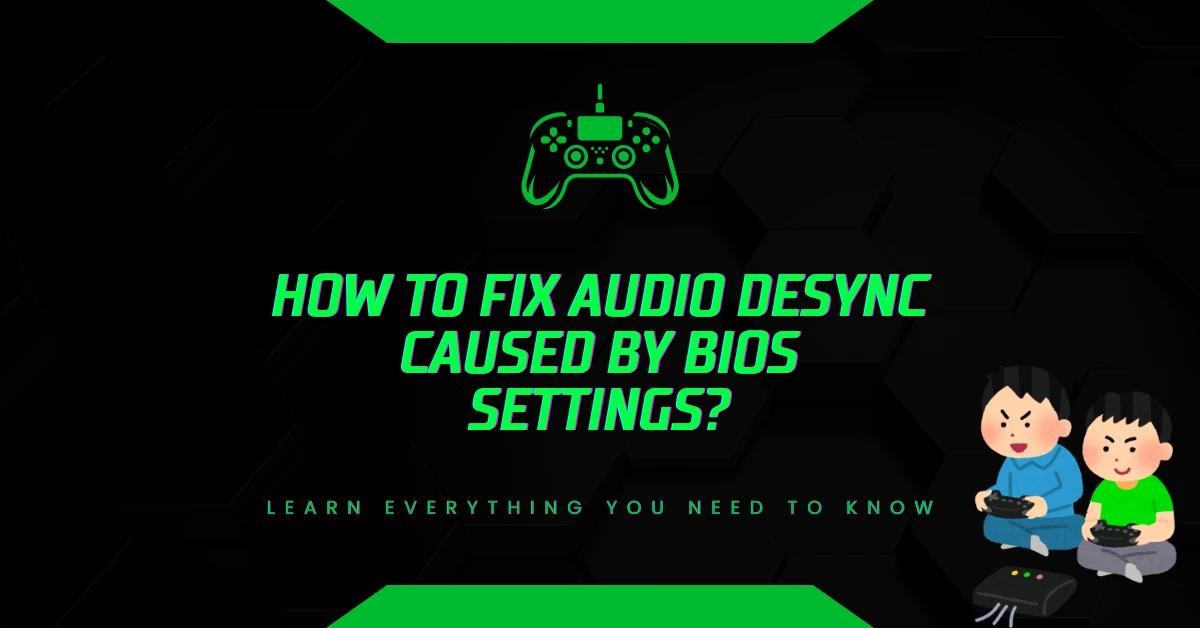How to Fix Audio Desync Caused by BIOS Settings?
Audio desync disrupts video playback, gaming, and streaming, especially when BIOS settings silently cause timing mismatches. Fixing this at the root saves hours of frustration.
What Is Audio Desync and Why BIOS Settings Matter ?
Audio desync happens when sound doesn’t match the visuals. You might hear dialogue before lips move or gunshots after muzzle flashes. This issue affects:
- Video editing software like Adobe Premiere Pro
- Streaming platforms such as Netflix or YouTube
- Gaming engines like Unreal Engine or Unity
While software glitches and outdated drivers often get blamed, BIOS settings can silently cause timing errors between your CPU, RAM, and audio chipset. BIOS (Basic Input/Output System) controls how hardware talks to your operating system. If it’s misconfigured, even high-end systems can suffer from lag or sync issues.
Signs Your BIOS Is Causing Audio Desync
Before talking about fixes, confirm if BIOS is the culprit. Look for these signs:
- Desync persists across multiple apps and media types
- Audio lag appears after system updates or hardware changes
- Sync issues worsen during high CPU usage
- No improvement after updating drivers or reinstalling software
If these symptoms match, BIOS settings may be interfering with audio timing.
Understanding BIOS Settings That Affect Audio Sync
BIOS settings control how fast and efficiently your system components communicate. Key settings that impact audio synchronization include:
Intel SpeedStep / AMD Cool’n’Quiet
These features adjust CPU speed based on workload. While they save power, they can cause inconsistent timing during audio playback.
Spread Spectrum
This setting reduces electromagnetic interference by slightly varying clock speeds. It can disrupt precise audio timing.
C-States (CPU Power States)
C-States allow CPUs to enter low-power modes. If enabled aggressively, they may delay audio processing.
XMP Profiles (Extreme Memory Profiles)
XMP boosts RAM performance. If misconfigured, it can cause latency spikes that affect audio sync.
PCIe Settings
Audio devices often connect via PCIe lanes. Improper lane configuration or Gen settings can cause bandwidth bottlenecks.
Step-by-Step Fix: How to Correct BIOS Settings for Audio Sync
Follow these steps to adjust BIOS settings safely and fix desync issues:
Step 1: Access BIOS Menu
- Restart your PC
- Press the BIOS key (usually DEL, F2, or ESC) during boot
- Enter the BIOS interface
Step 2: Disable CPU Power-Saving Features
- Locate Intel SpeedStep or AMD Cool’n’Quiet
- Set to Disabled
- Turn off C-States under CPU Configuration
Step 3: Turn Off Spread Spectrum
- Navigate to Advanced > Frequency Settings
- Set Spread Spectrum to Disabled
Step 4: Verify XMP Profile Stability
- Go to Memory Settings
- Enable XMP Profile 1
- Run a memory stress test using MemTest86 to ensure stability
Step 5: Check PCIe Configuration
- Under Advanced > PCIe Settings, set lanes to Auto or Gen3
- Avoid forcing Gen4 unless your hardware supports it fully
Step 6: Save and Exit
- Press F10 to save changes
- Reboot your system
Additional Fixes Beyond BIOS
If BIOS tweaks don’t fully resolve the issue, combine them with these system-level fixes:
Update Audio Drivers
Use official sources like Realtek or Intel to install the latest drivers.
Disable Audio Enhancements
- Go to Control Panel > Sound > Playback Devices
- Select your device > Properties > Enhancements
- Check Disable all enhancements
Set Correct Audio Format
- In Sound Settings, choose 24-bit, 48000 Hz (Studio Quality)
- This format matches most media standards
Use Dedicated Sound Card
If onboard audio struggles, install a PCIe sound card like ASUS Xonar AE or Creative Sound Blaster Z for better timing control.
Real-World Stats: Audio Desync and BIOS Impact
According to a 2023 survey by TechSpot, 18% of users reported audio desync issues after BIOS updates or hardware upgrades. In forums like Linus Tech Tips, BIOS misconfigurations were cited as a top cause of persistent audio lag in gaming setups.
A test by Tom’s Hardware showed that disabling C-States reduced audio latency by up to 35 milliseconds, enough to eliminate noticeable desync in most media playback.
Common Mistakes to Avoid
Avoid these errors when fixing BIOS-related audio issues:
- Resetting BIOS blindly: This can disable important features or worsen performance
- Overclocking without testing: Unstable CPU/RAM speeds can cause more desync
- Ignoring chipset drivers: BIOS works closely with motherboard drivers—keep them updated via manufacturer sites like ASUS or MSI
BIOS Update: When and How to Do It Safely ?
If your BIOS version is outdated, updating it may fix hidden bugs causing audio lag. Follow these steps:
Check Current BIOS Version
- Press Windows + R, type
msinfo32 - Look for BIOS Version/Date
Download Update from Manufacturer Site
Use official links only. For example:
- Gigabyte BIOS Downloads
- ASRock BIOS Center
Use USB Flash Method
- Format USB to FAT32
- Copy BIOS file
- Enter BIOS > Q-Flash / EZ Flash / M-Flash
- Follow on-screen instructions
Warning: Never interrupt a BIOS update. Power loss or crashes can brick your motherboard.
How BIOS Interacts With Audio Drivers and OS?
BIOS sets the foundation for how hardware communicates with Windows or macOS. If BIOS settings mismatch with audio drivers, timing errors occur. For example:
- LatencyMon can show if your system has high DPC latency
- Windows Event Viewer may log audio device errors linked to BIOS timing
BIOS also affects how DirectSound, WASAPI, and ASIO drivers perform. These are used in apps like OBS Studio, FL Studio, and Audacity.
Testing Audio Sync After Fixes
After making changes, test your system:
Use LatencyMon
- Download from Resplendence Software
- Run for 10 minutes during media playback
- Check for “hard pagefaults” and “ISR/DPC latency”
Play High-Frame Video
Use a synced video to verify timing.
Game Test
Play a fast-paced game like Call of Duty or Valorant. Check if gunfire and visuals match perfectly.
BIOS Settings Reference Table
| BIOS Setting | Recommended Value | Impact on Audio Sync |
|---|---|---|
| Intel SpeedStep | Disabled | Prevents CPU timing shifts |
| C-States | Disabled | Reduces latency fluctuations |
| Spread Spectrum | Disabled | Stabilizes clock timing |
| XMP Profile | Profile 1 | Ensures RAM timing consistency |
| PCIe Gen Setting | Gen3 or Auto | Avoids bandwidth bottlenecks |
Conclusion
Audio desync caused by BIOS settings is fixable with the right steps. By adjusting power states, clock configurations, and memory profiles, you can restore smooth, synchronized playback across all media and applications.
Frequently Asked Questions
Q. Can BIOS cause audio desync even on new PCs?
Yes. Factory BIOS settings may prioritize power saving over performance, causing timing mismatches.
Q. Will resetting BIOS fix audio lag?
Not always. Manual tuning is more effective than default resets.
Q. Is it safe to disable C-States?
Yes, for desktops. Laptops may lose battery efficiency.
Q. Do I need a sound card to fix this?
Not necessarily. Onboard audio can work well if BIOS and drivers are optimized.

Hi, I’m Leo Whitmore, author at bios-ps2.com. I’m passionate about gaming and tech. I love helping others enjoy retro gaming through simple guides and tools. Here, I share tips to make emulation easy and fun for everyone.
Contents
- 1 What Is Audio Desync and Why BIOS Settings Matter ?
- 2 Signs Your BIOS Is Causing Audio Desync
- 3 Understanding BIOS Settings That Affect Audio Sync
- 4 Step-by-Step Fix: How to Correct BIOS Settings for Audio Sync
- 5 Additional Fixes Beyond BIOS
- 6 Real-World Stats: Audio Desync and BIOS Impact
- 7 Common Mistakes to Avoid
- 8 BIOS Update: When and How to Do It Safely ?
- 9 How BIOS Interacts With Audio Drivers and OS?
- 10 Testing Audio Sync After Fixes
- 11 BIOS Settings Reference Table
- 12 Conclusion
- 13 Frequently Asked Questions







